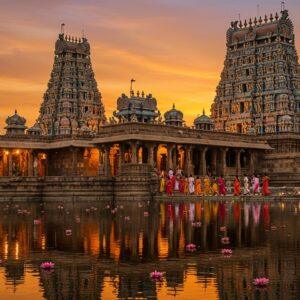
In the heart of Jainism, the Tirthankaras shine as beacons of spiritual wisdom and liberation. These enlightened souls, also known as “Ford Makers,” guide followers across the river of samsara (the cycle of birth and death) towards the shores of moksha (liberation). Let’s delve into the history and significance of these revered figures.
Who are the Tirthankaras?
The word “Tirthankara” comes from the Sanskrit words “tirtha” (a ford or crossing place) and “kara” (maker). They are not gods, but ordinary beings who, through intense spiritual practice, attain perfect knowledge and liberation. They then dedicate their lives to showing others the path to freedom from suffering. They are also known as “Teaching Gods,” “Crossing Makers,” and “Makers of the River-Crossing.”
- Ford Makers: They bridge the gap between the cycle of rebirths and liberation, helping others cross over to enlightenment.
- Saviors and Guides: Tirthankaras are seen as saviors who illuminate the path to spiritual awakening. They act as compassionate guides, offering teachings and inspiration.
- Not Divine Incarnations: Importantly, Tirthankaras are not considered incarnations of a God. They are individuals who, through their own efforts, achieve enlightenment.
- Achieved Through Practice: Tirthankara status is attained through dedicated austerity, profound meditation, and an unwavering, undisturbed disposition.
The Role and Importance of Tirthankaras
Tirthankaras play a multifaceted role in Jainism. They establish the Jain Sangha, or community, which includes monks, nuns, and laypeople. They preach the dharma, the righteous path, and their teachings form the foundation of Jain scriptures. Crucially, Tirthankaras aren’t worshipped for favors or blessings. Instead, they are revered as exemplary role models, inspiring followers to emulate their virtues and strive for spiritual growth.
- Spiritual Guides: They don’t just preach; they illuminate the spiritual journey, guiding followers toward true liberation. They offer a map to navigate life’s complexities.
- Establishing the Sangha: Tirthankaras establish a structured community that supports spiritual practice, providing a framework for growth. This includes monks, nuns, and laypeople – a fourfold order.
- Teachers of Dharma: As supreme preachers of dharma, their teachings form the very bedrock of Jain philosophy. They reaffirm the eternal truths and guide souls to moksha.
- Role Models: They embody the highest ideals of Jainism. They serve as living examples of the virtues needed to reach liberation. Their lives inspire devotees to strive for similar spiritual heights.
- Not Intercessors: Tirthankaras are not intermediaries who grant favors. They are respected and followed as ideal examples of spiritual accomplishment.
- Ethical Foundation: Their teachings establish the ethical doctrines that form the foundation of Jain life. They bring clarity to moral principles.
History and Timeline of the 24 Tirthankaras
Jain cosmology speaks of a cyclical time frame, with each cycle producing 24 Tirthankaras. Each Tirthankara teaches the same eternal truth, adapting their message to the specific era and culture. Rishabhanatha (also known as Adinatha) is the first Tirthankara of the present cycle. He is said to have taught essential life skills like agriculture and animal husbandry. Parshvanatha, the 23rd Tirthankara, lived approximately 250 years before Mahavira. Mahavira (Vardhamana), the 24th and most recent Tirthankara, lived in the 6th century BCE. He is credited with systematizing Jain doctrines and emphasizing the five great vows: Ahimsa (non-violence), Satya (truthfulness), Asteya (non-stealing), Brahmacharya (celibacy), and Aparigraha (non-possessiveness).
- Cosmic Time Cycle: Jainism views time as cyclical, with 24 Tirthankaras appearing in each cycle to guide humanity.
- Eternal Truth: While each Tirthankara tailors their message to their time, the core truths of Jainism remain constant. They present different facets of the same eternal wisdom.
- Rishabhanatha (Adinatha): The first Tirthankara of this cycle, he is associated with teaching practical skills like agriculture, animal husbandry, and even barter. He laid the foundation for a harmonious society.
- Parshvanatha: The 23rd Tirthankara, he lived about 250 years before Mahavira and paved the way for his successor’s teachings.
- Mahavira (Vardhamana): The 24th Tirthankara, he is the most recent and perhaps most well-known. He systematized Jain philosophy and emphasized the five great vows: Ahimsa, Satya, Asteya, Brahmacharya, and Aparigraha.
Key Concepts in Jainism
Several key concepts are central to understanding the role of Tirthankaras:
- Kevala Jnana (Omniscience): Upon attaining enlightenment, a Tirthankara possesses complete knowledge of the universe. This perfect knowledge is called Kevala Jnana.
- Moksha (Liberation): The ultimate goal in Jainism is moksha, freedom from the cycle of rebirth. Tirthankaras show the path to this liberation.
- Samavasarana (Divine Assembly): After attaining Kevala Jnana, a Tirthankara preaches the path to liberation in a divine assembly called Samavasarana.
- Five Great Vows (Mahavratas): These ethical principles, particularly emphasized by Mahavira, are fundamental to Jain practice: Ahimsa (non-violence), Satya (truthfulness), Asteya (non-stealing), Brahmacharya (celibacy or chastity), and Aparigraha (non-attachment or non-possessiveness).
Representations and Symbolism
Tirthankaras are often depicted in meditative postures, either standing (Kayotsarga) or seated cross-legged on a lion throne. They are also identified by specific colors and emblems. These artistic representations serve as reminders of their teachings and the path to liberation.
At Poojn.in, we understand the deep significance of these spiritual figures. We offer a wide selection of Jain idols and puja items, carefully crafted to honor these revered teachers. Explore our collection and bring the blessings of Jain dharma into your home.
Brass Panchmukhi Hanuman Idol
Brass Panchmukhi Hanuman Idol
Brass Lord Kubera Idol
thirunelli temple
thiruvanchikulam mahadeva temple
draksharama temple
bheemeswara swamy temple


